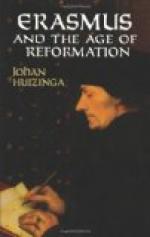Latrat et amittit, humilis,
vilis, negat, heret:
Est celeste
Canis sidus, in amne natat.
‘Firstly it is a thing that barks’: three verses of quotation follow.
’Secondly it loses; canis being the name for the worst throw with the dice’: one verse of quotation.
’Thirdly it is something humble: David to Saul, “After whom is the King of Israel come out? after a dead dog? after a flea?”
Fourthly it is something contemptible: Goliath to David, “Am I a dog that thou comest to me with staves?”
Fifthly it denies, like an apostate: “A dog returned to its vomit.”
Sixthly it adheres.’ But here the interpreter goes astray under the preoccupation of the times: ’heret significat hereticum et infidelem; hence “It is not good to take the children’s bread and cast it unto dogs, that is to heretics and infidels.”
Seventhly it is a star; hence are named the dog days, in which that star has dominion.
Eighthly it swims in the sea; the dog fish.’
The qualities of the dog are also expressed in this verse: ’Latrat in ede canis, nat in equore, fulget in astris. Et venit canis originaliter a cano—is.’ So Garland, or his commentator, abridged.
Of sal he says:
Est sal prelatus,
equor, sapientia, mimus,
Sal pultes condit,
sal est cibus et reprehendit.
Here again there is a full commentary; but the only interpretation that we need notice is the first, ’Salt denotes a prelate of the Church; for it is said in the Gospels, Ye are the salt of the earth.’ When he composed these lines, Garland must surely have had his eye on ecclesiastical preferment.
Another line is interesting, as illustrating the confusion between c and t in mediaeval manuscripts:
Est katonque malum, katademon nascitur inde.
The commentary runs: ’Kathon est idem quod malum. Inde dicitur kathodemon, i.e. spiritus malignus seu dyabolus, et venit a kathon, i.e. malum, et demon, sciens, quasi mala sciens.’ You will notice also the inconstancy of h, and the indifference to orthography which allows the same word to appear as katademon in the text and kathodemon in the commentary.
Garland’s Textus is mostly Latin; but in the last composition of his life, the forty-two distiches entitled Cornutus, ’one on the horns of a dilemma’, he is mainly occupied with Greek words adopted into Latin: using of course Latin characters. Some specimens will show the mediaeval standards of Greek: I quote from the text and commentary edited in 1481 by John Drolshagen, who was master of the sixth class at Zwolle.




